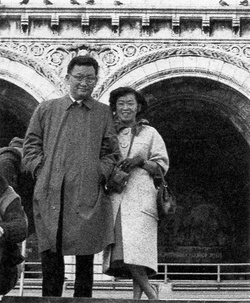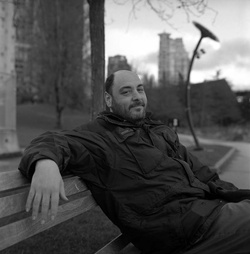“I was stunned when I started, and to some extent still am, at how rarely this precious source seemed to be used or cited by historians of Japanese Americans, notably those of the war years,” says scholar-author Greg Robinson.
Robinson is talking about the Pacific Citizen newspaper, which for more than 80 years has chronicled the Japanese American and broader Asian American communities. The paper is published by the Japanese American Citizens League (JACL), the nation’s oldest and largest Asian Pacific American civil rights organization.
The publication—and two of its pioneering journalists—are the subjects of Robinson’s new book, Pacific Citizens: Larry and Guyo Tajiri and Japanese American Journalism in the World War II Era. Through a meticulously compiled and annotated collection of articles and correspondence, plus an extended biographical introduction, Robinson uncovers a side of American history that has remained largely hidden from public view until now.
The book provides a rich narrative of wartime and post-war America, addressing a surprising range of subjects, from politics to cultural identity to interracial marriage.
“I became interested in Larry Tajiri when I was doing research on Franklin Roosevelt and Japanese Americans for what became my first book, By Order of the President,” says Robinson, a professor of history at the University of Quebec, Montreal. “I discovered the microfilm of the wartime issues of the Pacific Citizen and was bowled over by Tajiri’s extraordinary writings.”
“In the course of learning about Larry, I was lucky enough to meet and to get to know his wife, Guyo, in her last years,” Robinson adds. “And in the process, I got to discover some of her own great contributions as well.”
Robinson later met relatives and close friends of the Tajiris, and ultimately gained permission to use Larry Tajiri’s writings for a book. “I was greatly touched by their confidence in me,” he says.
“It proved to be a rather longer process than I expected to do the work,” Robinson recalls. “Once I started researching, I was amazed to discover how much Larry had actually written, and in how many diverse areas and publications. In addition to his writings for the Pacific Citizen, he wrote extensively for the prewar Nisei press, and contributed articles to such outside journals as The New Leader, Common Ground, and Asia, as well as writing a regular column for the African American magazine NOW.”
But while some of the writings in the book are from more than 70 years ago, Robinson notes that the content has important historical parallels to many issues in the present.
“Today we are once again in a situation where the government has acted under cover of war to limit the civil rights of Americans,” says Robinson. “Even now, the government has the power to arrest U.S. citizens, on American soil, and hold them indefinitely without charge. This greatly increases the chances of a new kind of outrage against American democracy, and the racial profiling of innocent people.”
“At the same time, what I think the book shows is that a recurrent theme of Larry Tajiri’s writings, throughout essentially his whole career, was that Japanese Americans could not stand alone in the fight for racial equality and democratic treatment,” Robinson observes. “They had to join with other groups, most notably with African Americans, and fight for civil rights for all: Larry actually went so far as to say that bigotry against Japanese Americans was simply a by-product of racism against Blacks. Larry was an outspoken supporter of Rev. Dr. Martin Luther King, Jr., and the civil rights movement in his last years, and warned Nisei not to be duped into opposing equal rights for Blacks.”
“Now, when there is widespread scapegoating of Muslims and prejudice against immigrants in America, these connections are once again important,” says Robinson. “I think that Larry would have spoken out in support of these groups. I also like to think that he would have supported equality for gays and lesbians against discrimination and violence, as Guyo later did in her quiet way. I can just imagine Larry writing one of his ripsnorter pieces to remind his Nisei peers that they, who had the experience of laws limiting their own marriage rights, had a responsibility to support equal access to marriage for others.”
Larry Tajiri was long sensitive to equal marriage rights, Robinson notes. The book reveals this most visibly through the Tajiris’ interaction with the famed artist/sculptor Isamu Noguchi and gives glimpses of Noguchi’s little-known civil rights activism.
“What is clear was that Larry and Guyo deeply admired Noguchi as an artist, an activist, and a person,” says Robinson. “During the 1940s, at a time when racial intermarriage was illegal in most states and marrying outside the community (especially with non-whites) was stigmatized even by a fair number of Issei and Nisei, Larry called for tolerance for mixed couples and pointed to Noguchi and [Broadway star] Sono Osato, who were both of mixed racial heritage, as living proof that intermarriage could produce outstanding children.”
While the book focuses primarily on the Japanese American experience in the United States, Robinson says that the Tajiris also left an important legacy for Japanese Canadians. “As an adopted Canadian, I have spent a great deal of time in the last decade studying the Japanese Canadian experience, and so one of the things that I was most gratified to discover in my research was that Larry Tajiri was very conscious of the plight of Japanese Canadians, and in some of the articles collected in the book, Larry does explain some of the similarities and differences between the condition of Issei and Nisei across the border.”
“One part of the strong support Larry offered Japanese Canadians is that he granted their newspaper New Canadian free permission to reprint any articles from the Pacific Citizen, and inspired other newspapers to follow suit,” says Robinson. “His generosity pays dividends to scholars now, since articles from long-defunct and now-unobtainable Nisei journals such as Crossroads were reprinted in the New Canadian, and are today accessible via archival copies.”
(Robinson recommends that readers seeking further information on Japanese Canadians explore the Canada section of Discover Nikkei. He also authored a book on the subject, A Tragedy of Democracy [Columbia University Press, 2009], which he says was the first large-scale work to look at Japanese American confinement alongside the treatment of Japanese Canadians.)
Having completed this new book, Robinson believes he’s gained an even greater respect for Japanese American journalism. “I have made it a point to look at as much of the mid-century Nisei press (at least in English) as I could get my hands on, and I have learned a lot from my reading,” says Robinson. “I am impressed by how much these journals expressed community members’ views and told people’s stories. They also included interesting additional information not found in mainstream press stories. I am convinced that using these sources has lent my historical work a particular character, and I hope a kind of rootedness, that makes it different from the more standard kinds of research based on unpublished archival documents or oral histories.”
Robinson adds that he feels a special journalistic kinship with the Tajiris because he writes a regular column for the Nichi Bei newspaper in San Francisco, the descendant of the journal Larry Tajiri edited. “(Through journalism) I have been able to interact with community members and become known inside the community a way that I could not have done simply as an academic historian and lecturer,” says Robinson. “In sum, if George Plimpton and other advocates of ‘participatory journalism’ gained fame during the 1960s for actually engaging in the activities they were writing about—professional sports, orchestral music playing, etc.—then perhaps I can claim, in my modest way, to have been a ‘participatory journalism historian,’ acting as a journalist and learning in the process about how journalists see things!”
* * *
BOOKS & CONVERSATIONS
Pacific Citizens by Greg Robinson
Japanese American National Museum
Saturday December 1, 2012
2-4 pm
Q&A to follow with Dr. Robinson and former Pacific Citizen Editor Harry Honda.
Purchase the book from the Museum Store >>
© 2012 Darryl Mori










